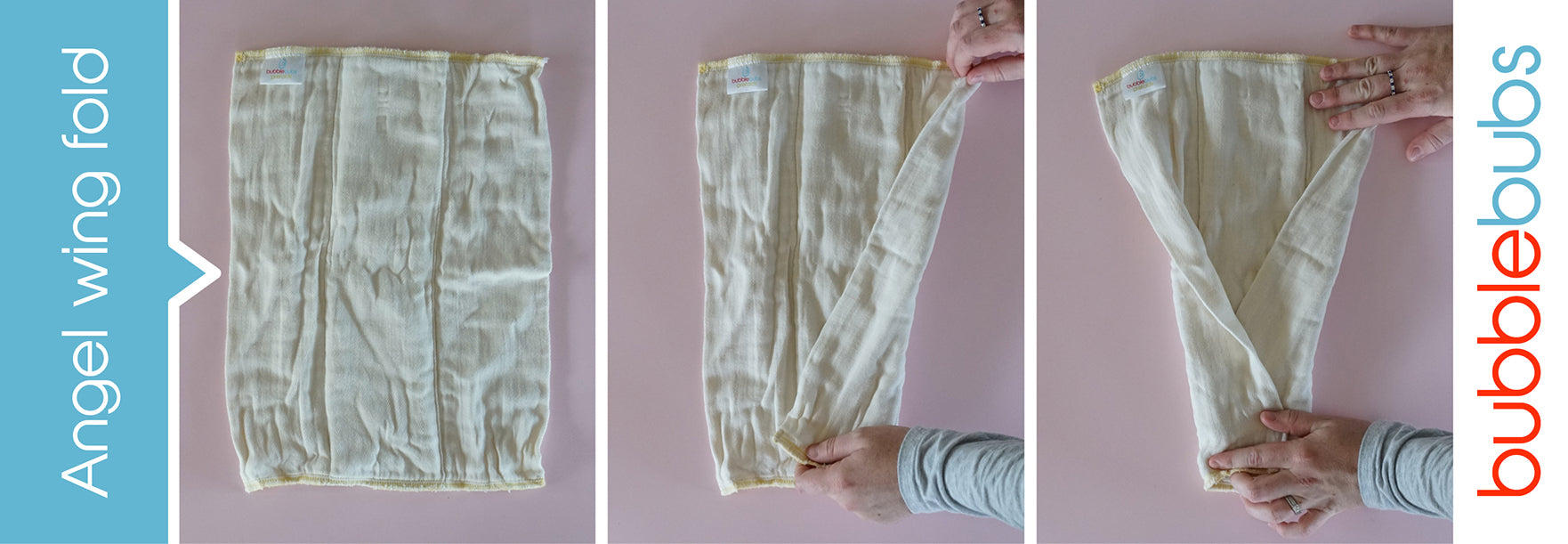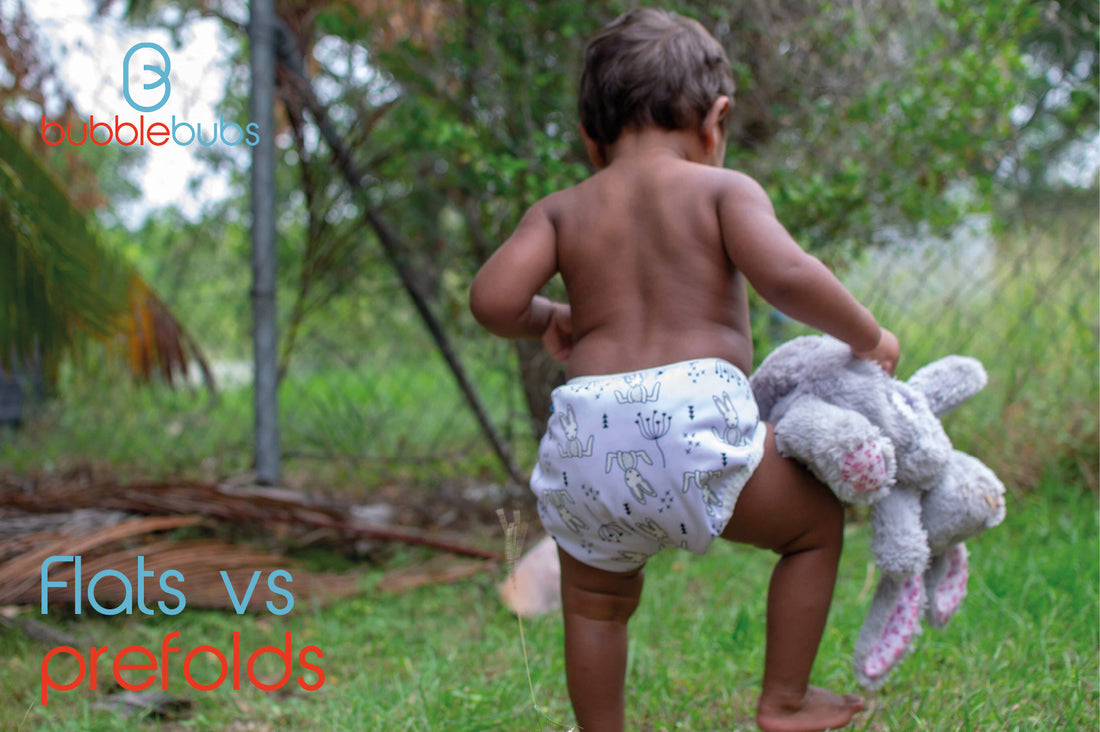We have a guest blogger this week, Amy! Amy White is on a mission to help Australian parents succeed with their cloth nappy goals. She is Mum to two boys and the owner of Clean Cloth Nappy Hire, supplying pristine packages of quality nappies across Australia.
Move over modern cloth, traditional cloth nappies are making a comeback! Flats and prefolds are cost-effective, versatile, easy to wash and fast to dry. As with all nappies, there can be a little trial & error as you find the perfect product for your baby. This post will take you through the pros & cons of using flats and prefolds and what you can expect from each.
Traditional flats are the white, fluffy, folded nappy squares that people think of when you say “cloth nappy”. Flats have stood the test of time and are an absorbent, economical option that can be folded in many ways to fit your baby.
The two most common fabrics are terry towelling and muslin (or Birdseye). Terry towelling is more absorbent than muslin, with the trade-off being that the nappy is bulkier on newborns and the nappy may appear huge in those first few weeks. Muslin is lightweight and trim fitting, making it perfect for newborns and smaller babies. Bubblebubs Muslin Flats come in a range of gorgeous colours which is great for those of you who love bright nappies.
Flats are really easy to wash (no soaking required, just use your usual nappy wash routine) and very fast to dry, making them a great option for wet winters and tropical summers. As the whole nappy is absorbent, you’ll need a separate cover over the top, though if you’re playing at home or out in the garden, many parents will go sans cover and just change when the nappy is wet.
Flats can be folded in different ways to fit babies of different sizes. When you’re starting out, try an “Origami Fold” for newborns and a “Kite Fold” for older bubs and be sure to check out Bubblebubs flat folding demonstration. You can get a great leg seal with your flats if you use the 10 and 2 Leg Seal Hack. This hack enables bub to kick their legs with ease and makes fitting covers a breeze!
Compared to a modern cloth nappy, flats don’t have any built-in stay-dry layers so if your bub is sensitive to moisture then you may like to place a microfleece liner on top of the folded nappy before fitting to your baby. You can also boost the absorbency of flats for older babies or night time use by placing a booster (be it bamboo/microfibre/a face washer/folded tea towel/any absorbent item) into the wet zone of the fold before fitting to your bub. A flat + cover is also a two-step nappy change. This means that flats can be tricky to use on wriggly crocodile-rolling babies who don’t want to lie still at change time. As with modern cloth nappies, you may need to upsize pants and onesies for good coverage and fit.
Flats are really versatile! You can pad-fold your flats (fold them into rectangles) and use them as inserts and boosters for your modern cloth nappies. Being fast to dry they are wonderful for camping and travelling. You can also use them as burp cloths, lightweight baby swaddles, pram blankets, as cleaning cloths, car polishing cloths and more. Flats are a great addition to any nappy stash, whether you use them full-time or just for a rainy day.
Prefolds are rectangle-shaped nappies made from layers of lightweight gauze/muslin. They are divided into three sections with the central (wet zone) section having the most layers. Prefolds are the traditional nappy of the USA and have become popular across the world in recent years.
Prefolds are typically made from cotton, though bamboo and help is available. At Bubblebubs we do a beautiful, stretchy bamboo stretchy prefold for newborns. See a comparison of our two prefolds here.
Prefolds require folding, but the folding is less intensive than for flats. Flats are typically folded before storage (in front of the TV at night was popular in our house!) but you can easily use a prefold without needing to fold it before use. For this reason they are slightly less labour intensive. The Angel Wing fold (see below) is easiest and is the most popular fold and as with the flats. We have several blogs and videos about using prefolds and Youtube is also a great resource. If you’re finding that your prefolds are too long and not wide enough, be sure to check out this video about how to resolve fit issues and get a great fit on your baby.

Prefolds come in different sizes, so you will need to use larger prefolds as your baby grows. This makes prefolds more expensive than flats though both are considerably less expensive than modern cloth nappies. As with flats, prefolds are not stay-dry so you may like to use a microfleece liner if your baby is sensitive to moisture and you’ll need a cover over the top.
When it comes to laundry, prefolds are the middle ground between flats and modern cloth nappies. Compared to flats, prefolds are slightly more difficult to wash as they have more layers. You may need to pre-treat your prefolds to prevent stains, but the layers are more lightweight than the heavy fabrics used in modern cloth nappies and they are easier to wash overall. Prefolds are slower to dry than flats but faster to dry than bamboo inserts from modern cloth nappies.
As with flats, prefolds can be used in many ways. They make amazingly absorbent inserts for pocket nappies by pad folding and placing into the pocket. They are great for mopping up spills around the home. You can boost them with inserts and use them as night nappies. They last for years and years and are great to pass onto a friend as you share the cloth nappy love.
Whichever you choose, flats and prefolds are an effective and inexpensive way to start your cloth nappy journey or add to your existing stash. Give them a go!
|
Product |
Pros |
Cons |
|
Muslin Flats |
Lightweight, fold to fit a variety of sizes, super fast to dry, great for travelling, many uses other than nappies |
Lower Absorbency, require folding |
|
Terry Flats |
Very absorbent, easy to wash, fast to dry, many uses other than nappies |
Bulky on newborns, 60x60cm size can be too small to last until toileting, require folding |
|
Prefolds |
More absorbent than Muslin Flats, less folding required, absorbency already centred in the wet zone |
Need to buy different sizes as baby grows, more layers means they can stain more easily than flats, longer drying time than flats |
Amy White is on a mission to help Australian parents succeed with their cloth nappy goals. She is Mum to two boys and the owner of Clean Cloth Nappy Hire, supplying pristine packages of quality nappies across Australia.

